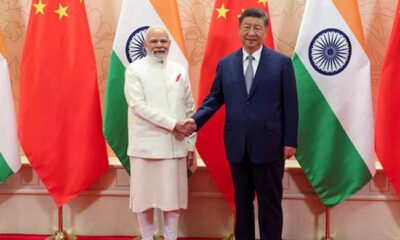Business
China’s Exports Decline for First Time in Eight Months – SUCH TV

China’s exports fell in October for the first time in eight months, official data showed Friday, as trade tensions simmered ahead of Chinese President Xi Jinping’s meeting with US President Donald Trump.
Shipments dropped 1.1 percent year-on-year, missing a Bloomberg forecast that had predicted a 2.9 percent rise.
Meanwhile, imports rose 1.0 percent, below September’s reading and short of the 2.7 percent increase expected by analysts, according to China’s General Administration of Customs.
The decline comes as China and the US reached a temporary detente in their trade war following Xi and Trump’s meeting in South Korea at the end of October.
The leaders agreed to suspend a range of tariffs and trade measures for a year, putting a temporary pause on months of tit-for-tat actions.
In the weeks leading up to the meeting, Beijing had imposed new restrictions on rare earth exports, a critical sector for defense and automotive industries.
In response, Trump threatened a 100 percent tariff on additional Chinese goods, though the plan was later scrapped after the summit, which Trump described as a “great success.”
Under the agreement, Washington halved tariffs on Chinese goods to 10 percent, while Beijing eased rare earth restrictions and lifted additional tariffs on US agricultural products, including soybeans, providing relief to American farmers.
Data showed China’s imports from the US fell 11.6 percent month-on-month in October, while its exports to the US rose 1.8 percent.
Economists noted that Chinese exporters had been frontloading trade to avoid higher US tariffs.
The country’s shipments to the US jumped 8.6 percent in September from August after falling 11.8 percent on-month from July.
“It seems the frontloading finally faded in October. As the trade war is put on hold for one year, exports will likely normalise,” Zhang said.
But, he warned: “Now that export momentum weakens, China needs to rely more on domestic demand.”
Business
Ruble surges in 2025: Russian currency emerges as top performer against US dollar; why it’s a headache for its war economy – The Times of India

The Russian currency Ruble emerged as the top-performing major currency against the US dollar this year, surging 45% since January. This unexpected strength caught Russian officials off guard and poses challenges for the country’s war-affected economy. The currency is now trading around 78 per dollar, similar to levels before Russia’s Ukraine invasion, as reported by Economic Times.The surge comes from several factors. Russians are buying less foreign currency due to international sanctions. High interest rates have also made ruble investments more attractive to locals. The central bank kept rates very high from October last year until June this year, before reducing them by 5 points to 16 per cent.This strong performance has exceeded government expectations, which predicted an average rate of 91.2 per dollar for the year. The ruble has stayed strong despite lower oil prices and new sanctions from the US and Europe. This strength is actually causing problems by reducing the value of export earnings when converted to rubles.The Bank of Russia has been supporting the currency by selling foreign currency, particularly yuan and gold, from the National Wellbeing Fund. This is helping offset declining energy revenues, with oil and gas income dropping 22% in the first 11 months of 2023.The ruble’s impressive performance puts it among the world’s top five performing assets this year, alongside precious metals like platinum, silver, palladium, and gold. Central Bank Governor Elvira Nabiullina sees this strength as helpful in fighting inflation, noting that its positive effects on prices haven’t yet peaked.
Business
Job seekers use AI for cover letters; employers turn to AI-led interviews — both are equally miserable, here’s why – The Times of India

Turned to artificial intelligence (AI) to help you stand out during the job process, but got rejected in the first round? Or are you a hiring manager who relied on AI to frisk through applications to select the best candidate, but ended up with not what you quite envisioned?The answer lies in the approach itself. Relying on artificial intelliegnce for job application might be doing you more harm than good.The growing use of artificial intelligence in recruitment is reshaping how Americans search for work, just as the country’s labour market shows signs of slowing. From automated interviews to AI-written cover letters, technology is now a part of almost every stage of the hiring process. But is it working? In 2025, more than half of organisations surveyed by the Society for Human Resource Management reported using AI tools to recruit workers. At the same time, almost one-third of ChatGPT users turned to the OpenAI chatbot for help with job applications. Yet recent research indicates that candidates who rely on AI during the application process are actually less likely to be hired, even as employers struggle to cope with a flood of applications. “The ability (for companies) to select the best worker today may be worse due to AI,” Anais Galdin, a researcher at Dartmouth told CNN Business. Galdin and Jesse Silbert of Princeton University examined tens of thousands of cover letters submitted on Freelancer.com, a job listing platform and found that after the launch of ChatGPT in 2022, cover letters became longer and more polished. However, employers placed less importance on them, making it harder to distinguish strong candidates from the wider pool. As a result, hiring rates dropped, and so did average starting wages, CNN reported. “If we do nothing to make information flow better between workers and firms, then we might have an outcome that looks something like this,” Silbert said, referring to the study’s findings.
A negative cycle
As application volumes rise, companies are increasingly automating interviews as well.According to a survey by recruitment software firm Greenhouse conducted in October, 54% of US job seekers said they had taken part in an AI-led interview. While virtual interviews became common during the pandemic in 2020, many employers now use AI systems to conduct interviews, without necessarily removing subjectivity from hiring decisions. “Algorithms can copy and even magnify human biases,” said Djurre Holtrop, a researcher who studies the use of asynchronous video interviews, algorithms and large language models in hiring.“Every developer needs to be wary of that,” CNN cited the expert. Daniel Chait, chief executive of Greenhouse, said the growing use of AI by both applicants and employers has created a negative cycle. “Both sides are saying, ‘This is impossible, it’s not working, it’s getting worse,’” Chait told CNN.
What’s next?
Despite these concerns, adoption of the technology continues with one estimate projecting that the market for recruitment technology will grow to $3.1 billion by the end of this year. At the same time, resistance is mounting from lawmakers, labour groups and workers worried about discrimination. Liz Shuler, president of the AFL-CIO labour union, described AI-driven hiring as “unacceptable”. “AI systems rob workers of opportunities they’re qualified for based on criteria as arbitrary as names, zip codes, or even how often they smile,” Shuler said in a statement to CNN. Several US states, including California, Colorado and Illinois, are introducing new laws and regulations aimed at setting standards for the use of AI in hiring. However, a recent executive order signed by US President Donald Trump raised questions about the future of state-level oversight. Samuel Mitchell, a Chicago-based employment lawyer, said the order does not “preempt” state law but adds to the “ongoing uncertainty” around regulation. He added that existing anti-discrimination laws still apply, even when companies use AI systems, and legal challenges are already emerging. In a case supported by the American Civil Liberties Union, a deaf woman is suing HireVue, an AI-powered recruitment company, alleging that an automated interview failed to meet legal accessibility standards. HireVue denied the claim, telling CNN that its technology reduces bias through a “foundation of validated behavioral science”. Even with these challenges, more and more AI is getting hiring access. New tools have made resume screening more sophisticated, potentially helping some candidates who may have been overlooked. But for those who value personal interaction, the shift has been unsettling. Jared Looper, an IT project manager in Salt Lake City, Utah, who previously worked as a recruiter, recently underwent an AI-led interview during his job search. He described the experience as “cold”, and said he initially hung up when contacted by the automated system. Looper said he worries about job seekers who have yet to adapt to a hiring environment where appealing to algorithms has become essential. “Some great people are going to be left behind.”
Business
Tariffs hit boots, bags and more as leather prices jump — and relief could be years away

Different types of leather are seen at the Rio of Mercedes cowboy boot factory, on July 31, 2025, in Mercedes, Texas.
Ronaldo Schemidt | AFP | Getty Images
Bootmaker Twisted X — known for its Western footwear — was thrown into chaos overnight when President Donald Trump imposed sweeping tariffs on imports in April.
The company turned a conference room at its Decatur, Texas, headquarters into a “tariff war room” as import costs on its finished work boots surged, shipments were paused mid-transit and invoices fluctuated so wildly that staff found themselves recalculating margins by the hour.
“A lot of other leather companies had to pause shipments because of the chaos and it felt like prices were going all over the place before you could take account,” Twisted X CEO Prasad Reddy told CNBC. “It was a very uncertain time.”
Twisted X wasn’t alone. Leather retailers big and small are facing similar challenges, and the result has been higher prices at the register that are unlikely to come down anytime soon.
Pre-tariff inventory is gone, while replacement orders cost far more. The products hitting shelves now were manufactured with more expensive hides, subjected to pricier foreign processing and shipped with higher freight costs than last year’s merchandise, industry experts said.
The Yale Budget Lab projects that leather goods prices will remain elevated by nearly 22% for at least the next one to two years, driven by inflation, supply chain bottlenecks and heavy tariff exposure, particularly across China, Vietnam, Italy and India.
“The reason why leather is hit so hard is twofold,” said John Ricco with the budget lab. “No. 1, some of these tariff rates that are the highest are placed on different countries where we import most leather. The second reason is that we just import a lot of leather, and, more broadly, apparel-related products from these trading partners than we make.”
The costs have already shown up for brands like Tapestry, owner of handbag makers Coach and Kate Spade. Executives told investors in August that tariff-related expenses could total $160 million, warning of “greater than previously expected profit headwinds” moving forward.
Chasing low costs
A pair of Twisted X boots starts the way most U.S. leather goods do: as a raw, salted cow hide from an American ranch. That hide is shipped overseas, usually to Asia, to be tanned into leather. For Twisted X, roughly half of its products are tanned in China, down from 90% in 2017, Reddy said.
Once turned into leather, the material typically is shipped to another factory — often in China, Vietnam, Mexico or India — to be cut, stitched and assembled, before finally returning to the U.S. as a finished product.
Under normal conditions, that global supply chain kept costs low. But reliance on foreign production backfired when the new duties took effect, Reddy said.
“When tariffs happened, everything stopped,” said Kerry Brozyna, president of the Leather and Hide Council of America. “So they [China] couldn’t take shipments in because if they took them in and they computed in the price of the tariff, they wouldn’t be able to sell them.”
Currently, the U.S. leather trade deficit is one of the widest in manufacturing. In 2023, the U.S. imported $1.37 billion in leather apparel while exporting just $92.7 million, a roughly 15-to-1 deficit, according to the Census Bureau. China alone supplies about one-third of all leather goods imported into the U.S.
“Being so reliant on many overseas productions methods ended up hurting many people in the industry in the beginning when they didn’t know exactly what was going to happen,” Reddy said. “At Twisted X, we have been working for a while to reduce reliance on China.”
As the duties took effect, Twisted X and many other leather companies rushed to exit China and encountered new problems: bottlenecks in Cambodia and Bangladesh, longer lead times in Vietnam, and a sudden 50% tariff on many Indian leather exports imposed in August.
By late summer, nearly every leather company was paying more at every stage — for hides, tanning, assembly and re-importation, according to Reddy.
“We saw all our channels to make boots keep getting more expensive until we were able to figure out a good solution,” Reddy said.
Conglomerates like Steve Madden are also feeling the impacts.
“The third quarter was challenging, driven largely by the impact of new tariffs on goods imported into the United States,” Edward Rosenfeld, chairman and CEO of Steve Madden, said on an earnings call in November.
Price increases
Many companies absorbed what they could, but that buffer is fading, Ricco said. Despite rerouting supply chains and moving production, Twisted X said it still had to raise prices around 1% to 3% this year.
“We look at it as a success,” Twisted X’s chief marketing officer, Tricia Mahoney, told CNBC. “Many competitors were looking at bigger increases and but we made sure to prioritize our customers and keep the prices as stable as possible. Next year could be tough but we are more prepared than ever.”
Already, leather luxury prices are up. Chanel’s iconic Classic Flap bag is about 5% more expensive than it was last year, after yet another round of price hikes this spring, according to luxury retail pricing data.
But, by 2026, the leather industry’s price shock will likely be more prominent, Ricco said. Analysts expect prices for leather footwear and accessories to rise roughly 22% over the next year or two and around 7% long term as higher tariffs, freight costs and scarce premium hides move through the system.
“2026 is going to probably be where rubber meets the road,” Ricco said. “They [leather companies] have to make these decisions about whether to pass cost increases on to consumers, whether to cut jobs and whether to reduce payments to shareholders.”
Domestic declines
Workers at the Rio of Mercedes cowboy boot factory put the finishing touches on boots on July 31, 2025, in Mercedes, Texas.
Ronaldo Schemidt | AFP | Getty Images
The decline of a once-booming domestic leather manufacturing industry is also reducing the options companies have to pivot away from the global supply chain.
In the 1950s, manufacturers employed more than 300,000 people in roughly 1,000 tanneries nationwide, mainly spread across the Midwest and Northeast, according to the Leather and Hide Council of America.
The workforce has fallen to around 50,000 in 2025, with the number of tanneries dwindling to a few hundred, per the council.
Reddy said the so-called golden age of domestic manufacturing is long gone.
The burden of tariffs has had the steepest impact on brands that rely on finished goods from Asia — not companies sourcing leather domestically. So far, rather than restoring U.S. manufacturing, as the Trump administration had predicated the tariffs on, many brands have responded by reshuffling suppliers overseas to contain costs, according to industry experts.
Women work in a leather factory in Kolkata, India, on November 25, 2025.
Nurphoto | Nurphoto | Getty Images
Cattle shortages
U.S. leather companies are also dealing with a raw material shortage, as there are simply fewer cattle hides to work with.
The U.S. cattle herd is at its smallest point since the 1950s following prolonged drought, rising feed costs and herd liquidation. Since hides are a mandatory byproduct of dairy and beef production, fewer cattle mean fewer hides — even as global demand for top-grade leather persists for handbags, upholstery and footwear.
“Few cattle means that what hides are left makes it more expensive to produce boots with high-quality leather that we use,” Reddy said.
For shoppers hoping for a discount by trading down for a synthetic, alternatives haven’t been spared either.
Many faux-leather and polyurethane materials rely on petrochemical inputs sourced from Asia, which also fall under the new tariff schedules. Retailers and industry analysts said synthetic footwear and handbags are seeing mid- to high-single-digit cost increases, according to industry estimates.
-

 Fashion1 week ago
Fashion1 week agoIndonesia’s thrift surge fuels waste and textile industry woes
-

 Tech1 week ago
Tech1 week agoT-Mobile Business Internet and Phone Deals
-

 Business1 week ago
Business1 week agoBP names new boss as current CEO leaves after less than two years
-

 Sports1 week ago
Sports1 week agoPKF summons meeting after Pakistani player represents India in kabaddi tournament
-

 Entertainment1 week ago
Entertainment1 week agoIndia streamlines visa rules in boost for Chinese professionals
-

 Sports1 week ago
Sports1 week agoUWCL grades for all 18 teams: Leuven get A+; Barça an A-, PSG fail
-
Sports5 days ago
Alabama turned Oklahoma’s College Football Playoff dream into a nightmare
-

 Entertainment1 week ago
Entertainment1 week agoRadiation fears rise after cracks found in $2 billion Chernobyl shield














